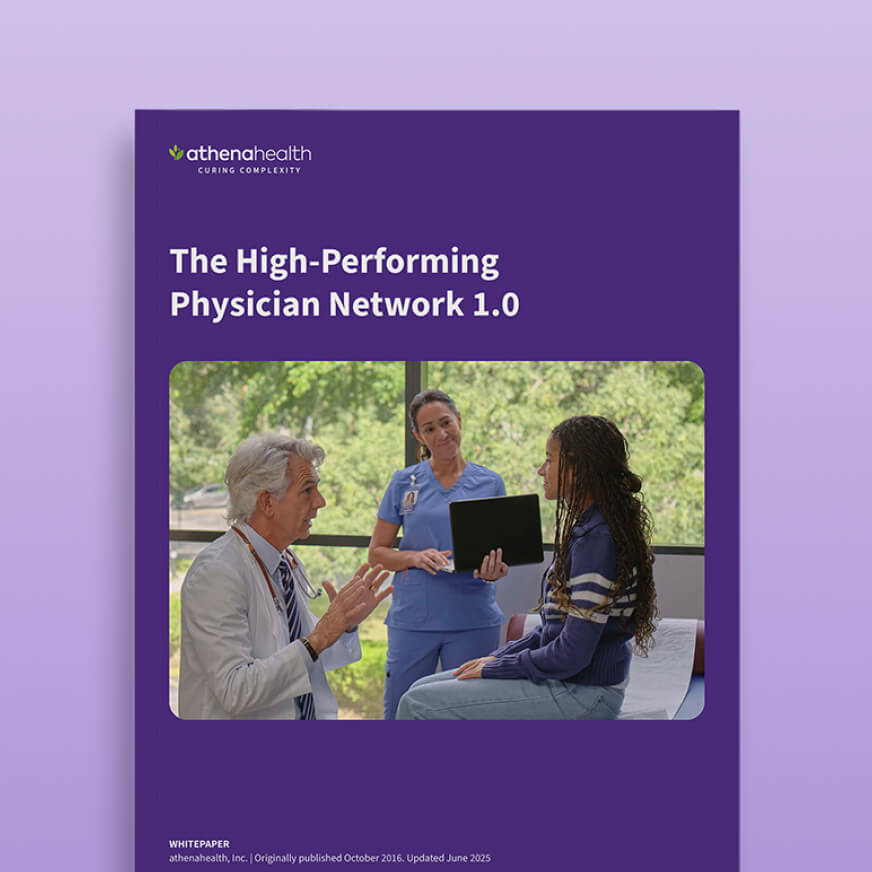Listening to physicians: What rising financial pressure means for policy and technology
Every year, we talk to physicians across the country to understand how they’re doing — financially, operationally, emotionally. And every year, we hear the same thing: rising costs, shrinking margins, and growing concern about whether the math still works.
Our latest Physician Sentiment Survey, conducted by Harris Poll and sponsored by our team at athenahealth, puts data to that reality. More than half of physicians say they’re concerned about their organization’s financial health.1 Reimbursement — from private but especially public payers — continues to dominate that concern.
We also know that financial strain doesn’t come from reimbursement levels alone. The cost to run a practice has grown steadily — from staffing and supplies to rent and labor costs, it’s getting more and more expensive to care for patients. In fact, according to the American Medical Association, the cost of running a practice has increased by 3.5% this year.2
At the same time, practices are investing in technology not as a cost center, but as a path to efficiency. Software, services, and security are now essential — required to meet regulatory standards, ensure privacy, optimize the revenue cycle, and participate in evolving payment models.
For many practices, these tools come with real return on investment: higher clean claims rates, faster payment, and fewer days in A/R. Health IT is not just a cost — it’s part of the solution to managing rising costs. But no amount of efficiency can offset the long-term damage of underpayment.
When operating costs are rising by 3.5% and Medicare cuts physician reimbursement by 2.8%, that’s more than a 6% swing in the wrong direction.3
What other business could survive that? Something has to give. Too often, it’s the sustainability of care — at the practice and the individual level.
What the data say to policymakers
One of the clearest signals from this year’s survey is just how widespread and bipartisan these financial concerns are. Sixty percent of physicians cite Medicare and Medicaid reimbursement as a top concern.4 That number holds across rural and urban areas, primary care and specialty, small practices and large systems.
If you’re on the Hill debating cuts to physician payment, know this: we’re not talking about abstract budget adjustments. We’re talking about real-world consequences — shorter visits, fewer appointments, and more patients left without access to care. Cuts don’t just reduce revenue. They remove flexibility, limit investment, and undercut the ability to adopt new tools, expand care access, or hire care team members.
And let’s be honest — the ones that are hit the hardest aren’t large hospital systems. They’re independent physicians down the street. The one who knows your family and sees your kid when they spike a fever. The one trying to keep the lights on while Medicare payments fall, and overhead costs rise.
Why we conduct this research
We’re not on the sidelines. As a healthcare IT company, we build the tools doctors use every day, and we feel the pressure they’re under, too. Our software and services play a role in the financial landscape of every practice we support. We recognize that as reimbursement gets tighter, the value we deliver must be higher. Our tools should help practices get paid faster, work more efficiently, and navigate payer complexity. One way to do that is through thoughtful AI integration — for example, tools like Ambient Notes can reduce documentation time and give physicians back time in their day — without sacrificing what’s billable.
We’re doing our part. We’re investing in better tools, smarter automation, and research that puts physician experience front and center. But technology alone can’t offset payment models that are structurally broken. That’s why we invest in this research. Because we believe elevating physician voices is essential to smart, informed healthcare policy. We want to help policymakers see what providers are experiencing — not through lobbyist talking points, but through data, stories, and day-to-day reality.
A call for thoughtful policy and collaborative solutions
At a time when Congress is actively debating funding levels for Medicare and Medicaid, the message from doctors couldn’t be clearer: this is the worst possible moment to squeeze the very people holding up the healthcare system. That said, there’s potential for progress. The House-passed reconciliation bill includes a provision that would increase Medicaid reimbursement for physicians — tying physician payment to 75% of the Medicare Economic Index (MEI) that tracks physician practice-cost inflation.5 That would be a significant step in the right direction, and a meaningful investment in sustaining care.
For policymakers, payers, and health IT leaders alike, the takeaway is the same: we are at a financial inflection point in healthcare. Physicians are doing more with less, for more patients, under more complex expectations. They need partners — not pressure. They need investment — not reductions.
This isn’t about politics — it’s about basic math. A system that costs more to run than it pays to sustain will fail. And when it does, patients are the ones left holding the bag.
There is a real opportunity to strengthen the foundation of care in this country. But that work begins with listening — and responding — to what physicians are telling us. As an industry and as a government, we must support their ability to deliver the care we all depend on.
Want to learn more about our findings? Download the full 2025 Physician Sentiment Survey report.
More athenaInstitute resources
Continue exploring
1. 2025 Physician Sentiment Survey of 1,001 physicians nationwide, commissioned by athenahealth and fielded by Harris Poll, Jan 2025.
2. AMA. (2025, March). Congress abandons Medicare patients and their physicians. https://www.ama-assn.org/press-center/ama-press-releases/congress-abandons-medicare-patients-and-their-physicians
3. CMS. (2024, November). Medicare Physician Fee Schedule Rule Summary. https://www.cms.gov/files/document/mm13887-medicare-physician-fee-schedule-final-rule-summary-cy-2025.pdf
4. 2025 Physician Sentiment Survey.
5. AMA. (2025, May). House budget: Hope on Medicare pay, but big concerns on Medicaid. https://www.ama-assn.org/practice-management/medicare-medicaid/house-budget-hope-medicare-pay-big-concerns-medicaid













